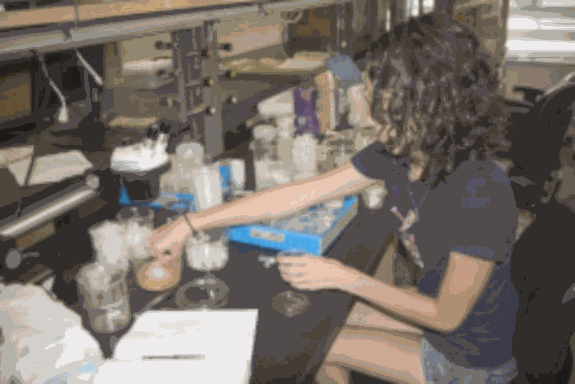Have you ever seen a three-foot dragonfly? Where such gigantic insects once dominated the Earth, now only diminutive cousins remain. What created these differences? Elyse Munoz, a junior majoring in biology in the Arizona State University (ASU) College of Liberal Arts and Sciences, had the rare opportunity to directly investigate this question over the summer, while participating in cutting-edge research in the lab of physiologist Jon Harrison.
The National Science Foundation (NSF) grant on which Munoz works was developed by John VandenBrooks, a post-doctoral fellow in the Harrison laboratory. Jennifer Hale, another life sciences undergraduate, is also working on this project. The goal of VandenBrook’s research is to understand how oxygen affects the body size of insects related to those that existed in the Paleozoic Era. A second goal is to determine whether the dimensions of insect tracheae (breathing tubes) can be used to estimate oxygen levels of the prehistoric Earth.
Why the link between oxygen and size? Models developed by scientists have suggested that levels of oxygen in Earth’s atmosphere have undergone some major shifts over time. For example, oxygen is believed to have reached 31% during the Paleozoic Era (today it is 21%), followed by a massive decline to as low as 135 in the Mesozoic Era. The gigantic insects occurred on Earth at the same time as the oxygen peak, suggesting that changes in atmospheric oxygen enabled and then eliminated these giants.
How can one measure the oxygen in prehistoric atmospheres? The idea that Munoz, Hale, VandenBrooks, and Harrison pursue is that the dimensions of insect’s tracheae can provide a key. They are measuring the effect of different oxygen levels on the dimensions of the bodies and tracheal tubes of German roaches. The reason the cockroach is interesting is that the species have lived for such a long time, existed during time periods of both high and low oxygen, and persist still today.
To study them, Munoz and Hale spent the summer raising cockroaches in tanks that contained different oxygen levels.
They measured the insects’ growth, and then took them to the U.S. Department of Energy’s Advanced Photon Source at Argonne National Laboratory. There, at the 32-ID x-ray beamline, Munoz, Hale, and VandenBrooks peered inside the cockroaches and collected images that will enable them to document the effect of oxygen level on the dimensions of the cockroaches’ tracheae.
The researchers also imaged many insect fossils that have been preserved in amber, an optically clear, petrified pitch from ancient plants. They hope to verify a method for estimating the oxygen content of ancient atmospheres from the ratio of trachea tubes size to body size in insects. If successful, this will be a major advance for biology and geology.
"In the lab, research experiences provide an internship-type training that let students actually do research, rather than just read or hear about it," said Harrison, a professor in the School of Life Sciences. "They learn practical techniques, as well as ways of thinking critically about the research process. They get to interact on a personal level with faculty, post-doctoral fellows, and graduate students, which helps them decide whether this is something they wish to do as a career."
Munoz connected with Harrison through the summer Undergraduate Research Experience program offered by the ASU School of Life Sciences. The program is just one of a number of undergraduate research programs in the school. Such opportunities are one reason that Munoz, a native of San Antonio, Texas, came to ASU with an award from the Hispanic Scholarship Fund.
A Barrett Honors College student fueled by a penchant for genetics and a desire to become a surgeon, Munoz discovered the life sciences research program while taking Harrison’s undergraduate course in anatomy and physiology; attending graduate students mentioned there was a summer research opening in the Harrison lab to do research with insects.
Munoz says that while she wasn’t exactly sure what the research entailed, she had enjoyed Harrison’s course. She applied and was accepted.
The summer undergraduate research program links students with mentors and existing grants from the NSF. Students receive fellowships and are paid while they learn first-hand what research is all about. — Addie Lennox (ASU)
The original ASU press release can be found here.

